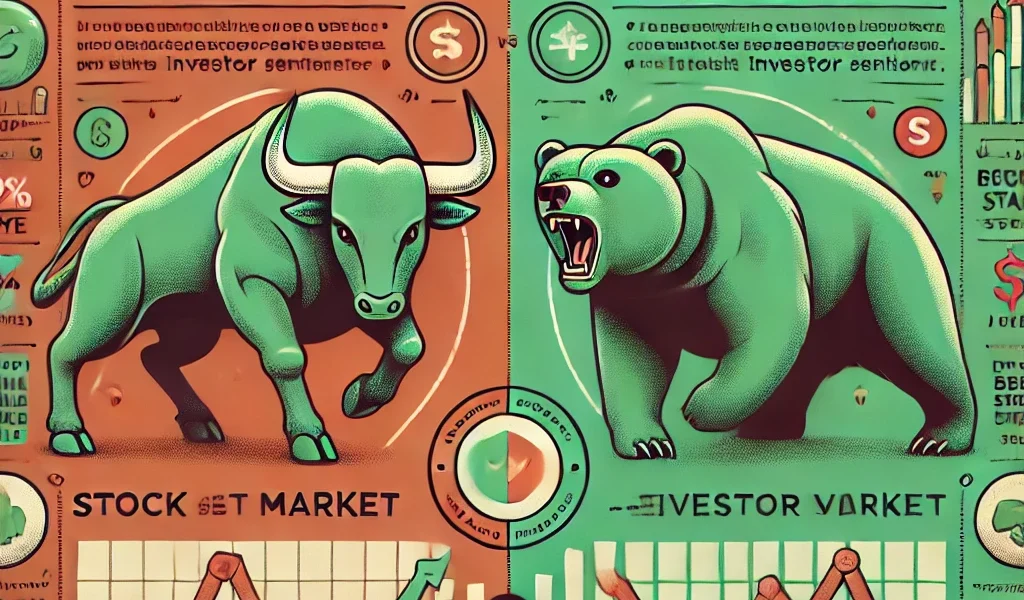The stock market moves in cycles, experiencing periods of growth and decline. These fluctuations are commonly referred to as bull and bear markets. Understanding these market cycles is essential for investors looking to make informed decisions, manage risks, and capitalize on opportunities.
In this guide, we will explore:
- What bull and bear markets are
- Key characteristics and indicators
- Factors influencing market cycles
- Strategies for investing in each phase
1. What is a Bull Market?
A bull market refers to a period of rising stock prices, generally accompanied by economic growth, increased investor confidence, and strong corporate earnings.
Key Characteristics of a Bull Market
- Rising Stock Prices: A sustained increase in stock prices, typically by 20% or more.
- Strong Economic Growth: Higher GDP growth, low unemployment rates, and strong consumer spending.
- Positive Investor Sentiment: Increased optimism and higher market participation.
- Higher Corporate Profits: Companies report stronger earnings, leading to further confidence.
Causes of a Bull Market
- Strong Economic Indicators: Rising GDP, higher employment rates, and increased productivity.
- Low Interest Rates: When central banks lower interest rates, borrowing becomes cheaper, encouraging investment.
- Government Policies: Tax cuts, stimulus packages, and economic reforms can drive market growth.
- Technological Advancements: Breakthroughs in technology often lead to market expansion and new investment opportunities.
2. What is a Bear Market?
A bear market is characterized by a prolonged decline in stock prices, typically a drop of 20% or more from recent highs. These periods are often linked to economic downturns or investor pessimism.
Key Characteristics of a Bear Market
- Falling Stock Prices: Declining stock values over an extended period.
- Economic Slowdown: Lower GDP growth, higher unemployment, and reduced consumer spending.
- Pessimistic Investor Sentiment: Fear and uncertainty lead to more selling than buying.
- Reduced Corporate Profits: Companies report lower earnings, often resulting in layoffs and cost-cutting measures.
Causes of a Bear Market
- Economic Recession: A slowdown in economic activity often triggers a market decline.
- High Interest Rates: When borrowing costs increase, businesses and consumers cut spending.
- Political or Global Events: Wars, pandemics, and geopolitical tensions can cause investor uncertainty.
- Stock Market Bubbles Bursting: Overvaluation of stocks can lead to a sharp correction when confidence drops.
3. Bull vs. Bear Markets: Key Differences
| Feature | Bull Market | Bear Market |
|---|---|---|
| Stock Prices | Rising | Falling |
| Investor Sentiment | Optimistic | Pessimistic |
| Economic Growth | Strong | Weak |
| Unemployment | Low | High |
| Interest Rates | Low | High |
| Market Participation | High | Low |
4. Phases of Stock Market Cycles
Both bull and bear markets go through different phases:
Bull Market Phases:
- Accumulation Phase: Institutional investors start buying stocks at lower prices before the uptrend begins.
- Public Participation Phase: More investors enter the market as prices rise steadily.
- Excess Phase: Over-optimism leads to excessive risk-taking and speculation.
- Peak Phase: The market reaches unsustainable highs before a downturn begins.
Bear Market Phases:
- Distribution Phase: Selling pressure increases as investors start losing confidence.
- Capitulation Phase: Panic selling occurs, driving stock prices down sharply.
- Stabilization Phase: Markets show signs of bottoming out as selling slows.
- Recovery Phase: A new bull market begins as investor confidence returns.
5. How to Invest in a Bull Market
During a bull market, investors can maximize returns by:
- Buying and Holding: Investing in strong companies and holding long-term.
- Growth Investing: Focusing on high-growth sectors like technology and healthcare.
- Sector Rotation: Identifying sectors that perform well in an expanding economy.
- Momentum Trading: Riding the trend of rising stock prices.
6. How to Invest in a Bear Market
Bear markets require caution and strategic planning:
- Defensive Stocks: Investing in recession-proof industries like healthcare and consumer staples.
- Dividend Stocks: Companies with strong cash flows can provide steady income during downturns.
- Hedging Strategies: Using options or bonds to protect against market declines.
- Buying Opportunities: Identifying undervalued stocks with long-term potential.
7. Conclusion
Stock market cycles are inevitable, and understanding the difference between bull and bear markets can help investors navigate market fluctuations effectively. While bull markets offer strong growth opportunities, bear markets require defensive strategies and patience.
Key Takeaways:
- A bull market is characterized by rising stock prices and strong economic growth.
- A bear market involves declining stock prices and economic slowdowns.
- Market cycles go through different phases, from accumulation to peak and decline.
- Adapting investment strategies based on market conditions can lead to better long-term results.




